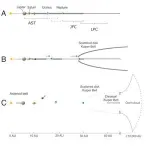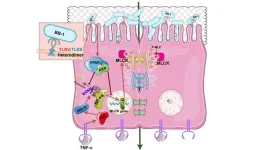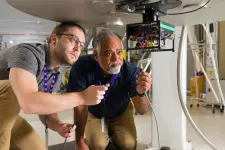(Press-News.org) BUFFALO, N.Y. — Air pollution is bad for mental health. That much is clear. Now, new research shows the impact may be even worse in neighborhoods that were historically redlined.
University at Buffalo researchers looked at 17 cities across New York State where longstanding federal housing policies once denied neighborhoods with people of color from receiving mortgages. Although this practice was outlawed in 1968, the researchers found that elevated levels of air pollutants in these neighborhoods of the state are disproportionately linked to increased emergency room (ER) visits for mental disorders.
“There was a significant association between air pollutant exposure and ER visits throughout these cities’ various neighborhoods, but it was most pronounced in their redlined communities, negatively impacting the vulnerable population that still lives there,” says Eun-Hye Enki Yoo, PhD, associate professor of geography in the UB College of Arts and Sciences.
Yoo is the lead author of the study, which will be featured in the Oct. 20 issue of Science of the Total Environment.
Linking pollution to ER visits
Redlining came about from New Deal-era government-insured mortgages. The Federal Housing Administration (FHA) rated communities’ lending risk from “A” to “D,” with D being considered the most risky and colored red on color-coded maps. These D-rated — or redlined — neighborhoods, not coincidentally, had higher populations of non-white residents, as the FHA concluded that homes near Black residents might lose property value.
Research has found that D-rated neighborhoods to this day have worse air quality, caused by proximity to industry and highways, and worse mental health, among other poor health outcomes.
“So the next logical question was whether these mental health outcomes are due, at least in part, to harmful environmental exposures,” says the study’s co-author, John Roberts, PhD, associate professor of psychology and associate director of clinical training in the UB Department of Psychology.
Elevated levels of pollutants are considered risk factors for anxiety, depression, schizophrenia, substance abuse disorders and dementia, but to substantiate a direct link, Yoo and Roberts collected deidentified New York State Department of Health patient records from 2005-16 and compared the data to daily air quality predictions by machine learning models. They focused on 17 cities where the federal government drew redlining maps, including Buffalo, Niagara Falls, Rochester, Albany and the boroughs of New York City.
They found that when levels of two pollutants, fine particulate matter and nitrogen dioxide, were elevated in D-rated neighborhoods, mental disorder-related ER visits there increased 1.04% and 0.44%, respectively, two days later.
Meanwhile, in A-rated neighborhoods, those the FHA once considered least risky, there was no association between elevated pollutants and subsequent increased ER visits.
However, the researchers note that the sample size for the A-rated neighborhoods was low, so they also compared the combined data of A- and B-rated neighborhoods with the combined data of C- and D-rated neighborhoods. While particulate matter had a significant effect on ER visits in both neighborhood groups, nitrogen dioxide, a gas associated with the burning of fossil fuels, did not have such an effect on the A and B group.
“Of course, there are many reasons, including social determinants of health, why there are more ER visits in one particular area than another, but we have methods, such as case-crossover design, that allows us to control for preexisting conditions and socioeconomic status,” Yoo says. “So the data showed rather conclusively that redlined neighborhoods bear the brunt of air pollution-induced mental health problems.”
The study also found that the association between elevated pollutants and increased ER visits only occurred during medium temperatures, 40 to 70 degrees Fahrenheit, and that
children under 18 and adults aged 35–64 were more susceptible to having air pollutants impact their mental health.
“Both these findings suggest being outdoors is a major factor in pollutant exposure, as people tend to be outside most during mild-weather days and younger people tend to be outside more than older people,” Yoo says.
Studies of Buffalo and beyond up next
Yoo has a $499,963 grant from the U.S. Environmental Protection Agency to install 30 air monitors across Buffalo’s East Side, a predominantly Black community with disproportionately negative health outcomes. It aims to provide even more accurate and localized air quality data than those provided by the predictive models in the current study.
Yoo is also collaborating with Oregon Health and Science University to analyze air pollution and mental health in historically redlined neighborhoods across the country.
“New York is not necessarily representative of the entire United States, so we’re excited to extend the framework of this study to a national analysis,” Yoo says. “We hope that more direct evidence may lead to policy change to do something about this problem.”
END
Air pollution harms mental health worse in New York’s historically redlined neighborhoods
Statewide study finds the link between pollutants and ER visits is more pronounced in communities that were once denied mortgages due to race
2024-08-22
ELSE PRESS RELEASES FROM THIS DATE:
Meteor showers shed light on where comets formed in the early solar system
2024-08-22
An international team of 45 researchers studying meteor showers has found that not all comets crumble the same way when they approach the Sun. In a paper published in the journal Icarus this week, they ascribe the differences to the conditions in the protoplanetary disk where comets formed 4.5 billion years ago.
“The meteoroids we see as meteors in the night sky are the size of small pebbles,” said lead author and SETI Institute and NASA Ames meteor astronomer Peter Jenniskens. “They are, in fact, the same size as the pebbles that collapsed into comets during the formation of ...
ChatGPT shows promise in answering patients' questions to urologists
2024-08-22
August 22, 2024 — The groundbreaking ChatGPT chatbot shows potential as a time-saving tool for responding to patient questions sent to the urologist's office, suggests a study in the September issue of Urology Practice®, an Official Journal of the American Urological Association (AUA). The journal is published in the Lippincott portfolio by Wolters Kluwer.
The artificial intelligence (AI) tool generated "acceptable" responses to nearly one-half of a sample of real-life patient questions, according to the new research ...
T cells manipulate the memory of innate immune cells
2024-08-22
Research from Radboud university medical center reveals that T cells from the adaptive immune system can manipulate the memory of innate immune cells. Previously, it was believed that the memory of innate immune cells operated independently. This surprising connection opens up new possibilities for the treatment of various diseases. A mouse model shows that no immunosuppressive drugs are needed after an organ transplantation if this interaction between T cells and the innate immunity is temporarily blocked after the transplantation.
The adaptive immune ...
Immune cells have a metabolic backup plan for accessing their anti-cancer playbook
2024-08-22
GRAND RAPIDS, Mich. (Aug. 22, 2024) — Immune cells use two different routes to produce acetyl-CoA, an essential metabolite required to fight infection and cancer, reports a study led by Van Andel Institute scientists.
The findings, published in the Journal of Experimental Medicine, could help improve immunotherapies by revealing how diet can boost immune cell function.
“Like any good system, immune cells have a plan A and a plan B,” said Russell Jones, Ph.D., the study’s corresponding author and chair of VAI’s Department of Metabolism and Nutritional ...
A 3D ion Magnet, the new experimental frontier for quantum information processing
2024-08-22
Many quantum devices, from quantum sensors to quantum computers, use ions or charged atoms trapped with electric and magnetic fields as a hardware platform to process information.
However, current trapped-ion systems face important challenges. Most experiments are limited to one-dimensional chains or two-dimensional planes of ions, which constrain the scalability and functionality of quantum devices. Scientists have long dreamed of stacking these ions into three-dimensional structures, but this has been very difficult ...
A potential pathway may guide new therapies for inflammatory bowel disease and other inflammatory diseases
2024-08-22
Philadelphia, August 22, 2024 – There is a critical unmet need to help tighten and maintain a healthy intestinal barrier and treat a leaky gut. Researchers have now found that a unique strain of probiotic bacteria, Bifidobacterium bifidum BB1, enhances intestinal barrier function and protects against penetration of bacteria and various harmful agents in the intestine. The findings, detailed in an article in The American Journal of Pathology, published by Elsevier, can help advance the development of novel, targeted, naturally occurring probiotic therapy for patients with inflammatory bowel disease (IBD) and other inflammatory diseases, such as fatty liver disease or alcoholic liver ...
CU researchers awarded $1.35 million grant to develop decision support technology for long-term care facilities
2024-08-22
Researchers from the University of Colorado College of Nursing and CU School of Medicine on the Anschutz Medical Campus were awarded a $1.35 million grant from the Agency for Healthcare Research and Quality (AHRQ) to design and implement technologies that improve resident safety and employee wellbeing at long-term care facilities.
“Long-term care facilities in the United States are in crisis, they’re facing low resources and high staff turnover,” CU Nursing Associate Professor and ...
Alzheimer’s drug may someday help save lives by inducing a state of “suspended animation”
2024-08-22
Researchers at the Wyss Institute for Biologically Inspired Engineering at Harvard University report that they were able to successfully put tadpoles of Xenopus laevis frogs into a hibernation-like torpor state using donepezil (DNP), a drug approved by the FDA to treat Alzheimer’s. The team had previously used another drug, SNC80, to achieve similar results in tadpoles and enhance the survival of whole mammalian hearts for transplants, but SNC80 is not approved for clinical use in humans because it can cause seizures. By contrast, DNP is already being used in the clinic, meaning it potentially could be rapidly repurposed ...
New NSF Center for Pandemic Insights
2024-08-22
Preventing the next pandemic begins before diseases emerge. This “pre-emergence” phase is the focus of a new center funded by the U.S. National Science Foundation and led by the University of California, Davis.
Supported with $18 million over seven years, the U.S. National Science Foundation Center for Pandemic Insights (NSF CPI) includes partnering institutions from across the United States. It aims to harness new technologies and develop sensing to detect, investigate, and ultimately prevent ...
FAMU-FSU College of Engineering research shows how insulin, zinc and pH can block harmful protein clumps linked to Type 2 diabetes
2024-08-22
An estimated 462 million people around the world suffer from Type 2 diabetes, a chronic disease in which the body has problems using sugar as a fuel, leading to a buildup of sugar in the blood and chronic health issues.
New research led by Ayyalusamy Ramamoorthy, a professor at the FAMU-FSU College of Engineering and the Florida State University-headquartered National High Magnetic Field Laboratory, shows how zinc, pH levels and insulin work together to inhibit the buildup of protein clumps that contribute to this disease. The work, which points toward promising avenues for innovative treatments, ...
LAST 30 PRESS RELEASES:
Brain immune cells may drive more damage in females than males with Alzheimer’s
Evidence-based recommendations empower clinicians to manage epilepsy in pregnancy
Fungus turns bark beetles’ defenses against them
There are new antivirals being tested for herpesviruses. Scientists now know how they work
CDI scientist, colleagues author review of global burden of fungus Candida auris
How does stroke influence speech comprehension?
B cells transiently unlock their plasticity, risking lymphoma development
Advanced AI dodel predicts spoken language outcomes in deaf children after cochlear implants
Multimodal imaging-based cerebral blood flow prediction model development in simulated microgravity
Accelerated streaming subgraph matching framework is faster, more robust, and scalable
Gestational diabetes rose every year in the US since 2016
OHSU researchers find breast cancer drug boosts leukemia treatment
Fear and medical misinformation regarding risk of progression or recurrence among patients with breast cancer
Glucagonlike peptide-1 receptor agonists and asthma risk in adolescents with obesity
Reviving dormant immunity: Millimeter waves reprogram the immunosuppressive microenvironment to potentiate immunotherapy without obvious side effects
Safety decision-making for autonomous vehicles integrating passenger physiological states by fNIRS
Fires could emit more air pollution than previously estimated
A new way to map how cells choose their fate
Numbers in our sights affect how we perceive space
SIMJ announces global collaborative book project in commemoration of its 75th anniversary
Air pollution exposure and birth weight
Obstructive sleep apnea risk and mental health conditions among older adults
How talking slows eye movements behind the wheel
The Ceramic Society of Japan’s Oxoate Ceramics Research Association launches new international book project
Heart-brain connection: international study reveals the role of the vagus nerve in keeping the heart young
Researchers identify Rb1 as a predictive biomarker for a new therapeutic strategy in some breast cancers
Survey reveals ethical gaps slowing AI adoption in pediatric surgery
Stimulant ADHD medications work differently than thought
AI overestimates how smart people are, according to HSE economists
HSE researchers create genome-wide map of quadruplexes
[Press-News.org] Air pollution harms mental health worse in New York’s historically redlined neighborhoodsStatewide study finds the link between pollutants and ER visits is more pronounced in communities that were once denied mortgages due to race





